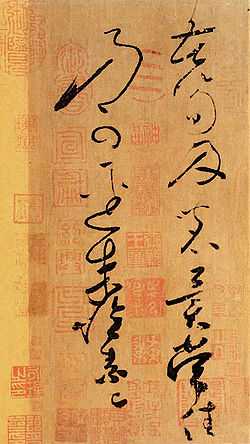Huai Su

Huai Su (simplified Chinese: 怀素; traditional Chinese: 懷素; pinyin: Huái Sù, 737–799),[1] courtesy name Zangzhen (藏真), was a Buddhist monk and calligrapher of the Tang Dynasty, famous for his cursive calligraphy. Fewer than 10 pieces of his works have survived.
He was born in modern Changsha, Hunan. Not much is known of his early life. His secular surname may have been Qian (錢). It is possible that Huai Su was a nephew of the poet Qian Qi (錢起). Huai became a monk in his childhood, apparently out of poverty.
Legend has it that he planted banana trees (or any genus of trees under Musaceae) in the courtyard of the temple he lived, and used the leaves as paper to practice his art.[2] He made his national fame in his early thirties when he came to Chang'an, which was then capital of China. Famous poets of his time spoke highly of his works, including Li Bai. Like Li Bai, he was fond of alcohol.
Traditionally Huai Su is paired with the older Zhang Xu as the two greatest cursive calligraphers of the Tang Dynasty. The duo is affectionately referred to as "the crazy Zhang and the drunk Su" (顛張醉素).
Notes
- ↑ Not to be confused with another monk of the same name of the Tang Dynasty, who, lived from 624 to 697, was a student of Xuanzang.
- ↑ His contemporary Lu Yu wrote in his Life of the monk Huai Su (僧懷素傳): "He was broke and had no paper for writing. So he planted tens of thousands of banana trees in his hometown [to obtain leaves] to practice his art (貧無紙可書,嘗於故里種芭蕉萬餘株,以供揮灑)".
References
- Zhu, Guantian, "Huai Su". Encyclopedia of China (Arts Edition), 1st ed.
External links
- Huai Su and his Calligraphy Gallery at China Online Museum
- Huai Su's Autobiography (in Classical Chinese)
- Bio with English (and hypertext dictionary)